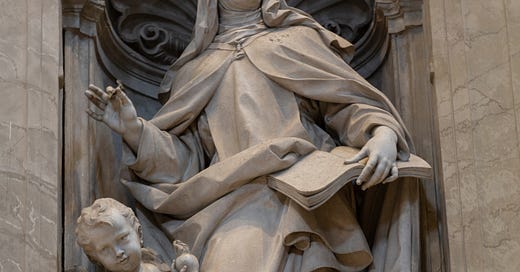She Waited for Rome
Before founding the Discalced Carmelites, St. Teresa sought the Pope’s permission
From the beginning, St. Teresa of Avila bound the reform of Carmel to the authority of the Holy Father. Her writings reveal a lifelong conviction that only with the Church’s blessing could the renewal of religious life take root and endure.
“One day, while I was in prayer, the Lord was pleased to show me the place that was prepared for me in hell because of the many sins I had committed. I was so terrified that, even now as I write about it, my blood grows cold.”
— The Book of Her Life 32.1
That vision never left her.
“It was at the time when Luther’s heresy was causing great harm, and I was very distressed over the many souls being lost. I often wept before the Lord, begging Him to remedy this evil.”
— The Book of Her Life 32.5“I resolved to do the small amount that was in my power: namely, to follow the evangelical counsels as perfectly as I could and strive that these few persons who live here do the same … trusting in the great goodness of God.”
— The Book of Her Life 32.6“I thought that if these few nuns were good, the Lord would be served greatly through them.”
— The Way of Perfection, Prologue 4
This resolution matured into a plan: to begin a new foundation of Carmelites who would return to the original spirit of prayer, penance, silence, poverty, and enclosure.
“A very holy man of the Order of St. Francis, Peter of Alcántara, whom the Lord had already brought to me, encouraged me to carry out this plan.”
— The Book of Her Life 32.8“He told me to strive for this foundation with all my powers, and he would help me, and that it was most important I begin.”
— The Book of Her Life 32.10
But Teresa did not act on impulse. She consulted theologians. She obeyed her confessors. She planned the work. And she waited.
On 7 February 1562, Pope Pius IV issued the brief Ex parte vestra, granting her permission to found a new monastery in Avila.
“The Lord gave me great courage when I saw that His Holiness had authorized the monastery. I thought of the many things I had suffered and how the work had not been judged favorably, and I praised the Lord.”
— The Book of Her Foundations 1.6
Saint Teresa’s courage was the fruit of obedience.
⬦ Reflection Question ⬦
What does St. Teresa’s patience and obedience teach me about trusting the Church in times of uncertainty?
⬦ Join the conversation in the comments.
Source reference
Teresa of Avila, St. 1985, The Collected Works of St. Teresa of Avila, translated from the Spanish by Kavanaugh, K; Rodriguez, O, ICS Publications, Washington DC.
Featured image
This marble statue of St. Teresa of Ávila, created by Filippo della Valle in 1754, is located in a niche along the nave of St. Peter’s Basilica. The sculpture shows the saint holding a quill pen and a manuscript, lifting her gaze toward heaven—a symbolic gesture of her obedience and reforming mission.
Image credit: vesta48 / Adobe Stock





